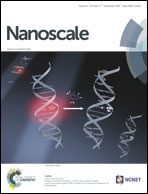Controllable copper deficiency in Cu2−xSe nanocrystals with tunable localized surface plasmon resonance and enhanced chemiluminescence†
Abstract
Copper chalcogenide nanocrystals (CuCNCs) as a type of semiconductor that can also act as efficient catalysts are rarely reported. Herein, we study water-soluble size-controlled Cu2−xSe nanocrystals (NCs), which are copper deficient and could be prepared by a redox reaction with the assistance of surfactants. We found them to have strong near-infrared localized surface plasmon resonance (LSPR) properties originating from the holes in the valence band, and also catalytic activity of more than a 500-fold enhancement of chemiluminescence (CL) in a luminol–H2O2 system. Investigations into the mechanisms behind these results showed that the high concentration of free carriers in Cu2−xSe NCs, which are derived from their high copper deficiencies that make Cu2−xSe NCs both good electron donors and acceptors with high ionic mobility, could greatly enhance the catalytic ability of Cu2−xSe NCs to facilitate electron-transfer processes and the decomposition of H2O2 into OH˙ and O2˙−, which are the commonly accepted key intermediates in luminol CL enhancement. Thus, it can be concluded that controllable copper deficiencies that are correlated with their near-infrared LSPR are critically responsible for the effective catalysis of Cu2−xSe NCs in the enhanced CL.


 Please wait while we load your content...
Please wait while we load your content...